Influence of Process Parameters on Properties of Non-Reactive RF Magnetron-Sputtered Indium Tin Oxide Thin Films Used as Electrodes for Organic Light-Emitting Diodes
Abstract
1. Introduction
2. Experimental Details
3. Results and Discussion
4. Conclusions
Author Contributions
Funding
Data Availability Statement
Conflicts of Interest
References
- Chavan, G.T.; Kim, Y.; Khokhar, M.Q.; Hussain, S.Q.; Cho, E.C.; Yi, J.; Ahmad, Z.; Rosaiah, P.; Jeon, C.W. A Brief Review of Transparent Conducting Oxides (TCO): The Influence of Different Deposition Techniques on the Efficiency of Solar Cells. Nanomaterials 2023, 13, 1226. [Google Scholar] [CrossRef]
- Lan, L.; Dai, X.; He, C.; Liu, L.; Yang, X.; Liang, L.; Cao, H.; Peng, J. Improving Negative-Bias-Temperature-Stress Stability for Thin-Film Transistors by Doping Mg Into ScInO Semiconductor. IEEE Trans. Electron Devices 2019, 66, 2620–2623. [Google Scholar] [CrossRef]
- Song, W.; Lan, L.; Xiao, P.; Lin, Z.; Sun, S.; Li, Y.; Song, E.; Gao, P.; Zhang, P.; Wu, W.; et al. High-Mobility and Good-Stability Thin-Film Transistors with Scandium-Substituted Indium Oxide Semiconductors. IEEE Trans. Electron Devices 2016, 63, 4315–4319. [Google Scholar] [CrossRef]
- Liguori, R.; Nunziata, F.; Aprano, S.; Maglione, M.G. Overcoming Challenges in OLED Technology for Lighting Solutions. Electronics 2024, 13, 1299. [Google Scholar] [CrossRef]
- Huseynova, G.; Lee, J.H.; Kim, Y.H.; Lee, J. Transparent Organic Light-Emitting Diodes: Advances, Prospects, and Challenges. Adv. Opt. Mater. 2021, 9, 2002040. [Google Scholar] [CrossRef]
- Liu, L.; Cao, K.; Chen, S.; Huang, W. Toward See-Through Optoelectronics: Transparent Light-Emitting Diodes and Solar Cells. Adv. Opt. Mater. 2020, 8, 2001122. [Google Scholar] [CrossRef]
- Jung, H.S.; Eun, K.; Kim, Y.T.; Lee, E.K.; Choa, S.H. Experimental and numerical investigation of flexibility of ITO electrode for application in flexible electronic devices. Microsyst. Technol. 2017, 23, 1961–1970. [Google Scholar] [CrossRef]
- Ali, M.K.M.; Ibrahim, K.; Pakhuruddin, M.; Faraj, M. Optical and Electrical Properties of Indium Tin Oxide (ITO) Thin Films Prepared by Thermal Evaporation Method on Polyethylene Terephthalate (PET) Substrate. Adv. Mater. Res. 2012, 545, 393–398. [Google Scholar] [CrossRef]
- Kutlimratov, A.; Zufarov, M.A.; Kabulov, R.R.; Xajiyev, M.U. Structial, Electrophysical, and Optical Properties of ITO Films Produced by the Modified CVD Method. Appl. Sol. Energy 2022, 58, 497–502. [Google Scholar] [CrossRef]
- Zuev, D.A.; Lotin, A.A.; Novodvorsky, O.A.; Lebedev, F.V.; Khramova, O.D.; Petuhov, I.A.; Putilin, P.N.; Shatohin, A.N.; Rumyanzeva, M.N.; Gaskov, A.M. Pulsed laser deposition of ITO thin films and their characteristics. Semiconductors 2012, 46, 410–413. [Google Scholar] [CrossRef]
- Hinna, M.; Hartiti, B.; Gouya, A.; Labrim, H.; Fadili, S.; Tahri, M.; Belfhailli, A.; Siadat, M.; Thévenin, P. Synthesis of ITO thin films by Spray pyrolysis based on Taguchi design. Mater Today Proc. 2022, 66, 447–455. [Google Scholar] [CrossRef]
- Wang, K.; Jiao, P.; Cheng, Y.; Xu, H.; Zhu, G.; Zhao, Y.; Jiang, K.; Zhang, X.; Su, Y. ITO films with different preferred orientations prepared by DC magnetron sputtering. Opt. Mater. 2022, 134, 113040. [Google Scholar] [CrossRef]
- Hacini, A.; Ali, A.H.; Adnan, N.N. Optimization of ITO thin film properties as a function of deposition time using the swanepoel method. Opt. Mater. 2021, 120, 111411. [Google Scholar] [CrossRef]
- Zhang, W.; Zhu, G.; Zhi, L.; Yang, H.; Yang, Z.; Yu, A.; Xu, H. Structural, electrical and optical properties of indium tin oxide thin films prepared by RF sputtering using different density ceramic targets. Vacuum 2012, 86, 1045–1047. [Google Scholar] [CrossRef]
- Aydin, E.; Altinkaya, C.; Smirnov, Y.; Yaqin, M.A.; Zanoni, K.P.; Paliwal, A.; Firdaus, Y.; Allen, T.G.; Anthopoulos, T.D.; Bolink, H.J.; et al. Sputtered transparent electrodes for optoelectronic devices: Induced damage and mitigation strategies. Matter 2021, 4, 3549–3584. [Google Scholar] [CrossRef]
- Chauhan, R.N.; Tiwari, N. Preparation of optically transparent and conducting radio-frequency sputtered indium tin oxide ultrathin films. Thin Solid Film. 2021, 717, 138471. [Google Scholar] [CrossRef]
- Daza, L.; Acosta, M.; Castro-RodrÍGUEZ, R.; Iribarren, A. Tuning optical properties of ITO films grown by rf sputtering: Effects of oblique angle deposition and thermal annealing. Trans. Nonferrous Met. Soc. China 2019, 29, 2566–2576. [Google Scholar] [CrossRef]
- Gudmundsson, J.T. Physics and technology of magnetron sputtering discharges. Plasma Sources Sci. Technol. 2020, 29, 113001. [Google Scholar] [CrossRef]
- David, C.; Tinkham, B.; Prunici, P.; Panckow, A. Highly conductive and transparent ITO films deposited at low temperatures by pulsed DC magnetron sputtering from ceramic and metallic rotary targets. Surf. Coatings Technol. 2017, 314, 113–117. [Google Scholar] [CrossRef]
- Kleinhempel, R.; Kaune, G.; Herrmann, M.; Kupfer, H.; Hoyer, W.; Richter, F. Properties of ITO films prepared by reactive magnetron sputtering. Microchim. Acta 2006, 156, 61–67. [Google Scholar] [CrossRef]
- Safi, I. Recent aspects concerning DC reactive magnetron sputtering of thin films: A review. Surf. Coatings Technol. 2000, 127, 203–218. [Google Scholar] [CrossRef]
- Diletto, C.; D’Angelo, A.; Esposito, S.; Guglielmo, A.; Gattia, D.M.; Lanchi, M. Materials Based on Amorphous Al2O3 and Composite W-Al2O3 for Solar Coatings Deposited by High-Rate Sputter Processes. Solar 2023, 3, 113–131. [Google Scholar] [CrossRef]
- Ren, Y.; Liu, P.; Liu, R.; Wang, Y.; Wei, Y.; Jin, L.; Zhao, G. The key of ITO films with high transparency and conductivity: Grain size and surface chemical composition. J. Alloys Compd. 2022, 893, 162304. [Google Scholar] [CrossRef]
- Gwamuri, J.; Marikkannan, M.; Mayandi, J.; Bowen, P.; Pearce, J. Influence of Oxygen Concentration on the Performance of Ultra-Thin RF Magnetron Sputter Deposited Indium Tin Oxide Films as a Top Electrode for Photovoltaic Devices. Materials 2016, 9, 63. [Google Scholar] [CrossRef] [PubMed]
- Najwa, S.; Shuhaimi, A.; Talik, N.; Ameera, N.; Sobri, M.; Rusop, M. In-situ tuning of Sn doped In2O3 (ITO) films properties by controlling deposition Argon/Oxygen flow. Appl. Surf. Sci. 2019, 479, 1220–1225. [Google Scholar] [CrossRef]
- Miao, J.; Fan, T. Flexible and stretchable transparent conductive graphene-based electrodes for emerging wearable electronics. Carbon 2023, 202, 495–527. [Google Scholar] [CrossRef]
- Pode, R. Organic light emitting diode devices: An energy efficient solid state lighting for applications. Renew. Sustain. Energy Rev. 2020, 133, 110043. [Google Scholar] [CrossRef]
- Hong, G.; Gan, X.; Leonhardt, C.; Zhang, Z.; Seibert, J.; Busch, J.M.; Bräse, S. A Brief History of OLEDs—Emitter Development and Industry Milestones. Adv. Mater. 2021, 33, 2005630. [Google Scholar] [CrossRef]
- Negi, S.; Mittal, P.; Kumar, B. Impact of different layers on performance of OLED. Microsyst. Technol. 2018, 24, 4981–4989. [Google Scholar] [CrossRef]
- Liu, S.; Xie, W.; Lee, C.S. Organic light-emitting diodes, what’s next? Next Nanotechnol. 2023, 1, 100003. [Google Scholar] [CrossRef]
- Tang, C.W.; Van Slyke, S.A. Organic electroluminescent diodes. Appl. Phys. Lett. 1987, 51, 913–915. [Google Scholar] [CrossRef]
- Chuang, M. ITO Films Prepared by Long-throw Magnetron Sputtering without Oxygen Partial Pressure. J. Mater. Sci. Technol. 2010, 26, 577–583. [Google Scholar] [CrossRef]
- Saenko, A.V.; Vakulov, Z.E.; Klimin, V.S.; Bilyk, G.E.; Malyukov, S.P. Effect of Magnetron Sputtering Power on ITO Film Deposition at Room Temperature. Russ. Microelectron. 2023, 52, 297–302. [Google Scholar] [CrossRef]
- Kudryashov, D.; Gudovskikh, A.; Zelentsov, K. Low temperature growth of ITO transparent conductive oxide layers in oxygen-free environment by RF magnetron sputtering. J. Phys. Conf. Ser. 2013, 461, 012021. [Google Scholar] [CrossRef]
- Tchenka, A.; Agdad, A.; Vall, M.C.S.; Hnawi, S.K.; Narjis, A.; Nkhaili, L.; Ibnouelghazi, E.; Ech-Chamikh, E. Effect of RF Sputtering Power and Deposition Time on Optical and Electrical Properties of Indium Tin Oxide Thin Film. Adv. Mater. Sci. Eng. 2021, 2021, 556305. [Google Scholar] [CrossRef]
- Asri, R.; Hamzah, N.; Ahmad, M.; Taib, M.M.; Sahil, S.; Hassan, Z. Role of RF Magnetron Sputtering Power on Optical and Electrical Properties of ITO Films on Soda-Lime Glass Substrates. J. Phys. Conf. Ser. 2020, 1535, 012035. [Google Scholar] [CrossRef]
- Schiller, S.; Heisig, U.; Goedicke, K. Use of the ring gap plasmatron for high rate sputtering. Thin Solid Films 1977, 40, 327–334. [Google Scholar] [CrossRef]
- Robb, A.J.; Duca, Z.A.; White, N.; Woodell, P.; Ward, P.A. Influence of oxygen on the optical and electrical properties of magnetron-sputtered indium tin oxide thin films at ambient temperature. Thin Solid Films 2024, 788, 140152. [Google Scholar] [CrossRef]
- Yasrebi, N.; Bagheri, B.; Yazdanfar, P.; Rashidian, B.; Sasanpour, P. Optimization of Sputtering Parameters for the Deposition of Low Resistivity Indium Tin Oxide Thin Films. Acta Metall. Sin. Engl. Lett. 2014, 27, 324–330. [Google Scholar] [CrossRef]
- Sousa, M.; da Cunha, A. Optimization of low temperature RF-magnetron sputtering of indium tin oxide films for solar cell applications. Appl. Surf. Sci. 2019, 484, 257–264. [Google Scholar] [CrossRef]
- Li, J.; Jiang, L.; Li, X.; Luo, J.; Liu, J.; Wang, M.; Yan, Y. Different Crystallization Behavior of Amorphous ITO Film by Rapid Infrared Annealing and Conventional Furnace Annealing Technology. Materials 2023, 16, 3803. [Google Scholar] [CrossRef] [PubMed]
- Nasir, M.F.B.M.; Mamat, M.H. Effect of substrates temperature on structural and optical properties indium tin oxide prepared by RF magnetron sputtering. In Proceedings of the 2016 IEEE Student Conference on Research and Development (SCOReD), Kuala Lumpur, Malaysia, 13–14 December 2016; pp. 1–4. [Google Scholar] [CrossRef]
- Chen, Y.; Zhou, Y.; Zhang, Q.; Zhu, M.; Liu, F. The correlation between preferred orientation and performance of ITO thin films. J. Mater. Sci. Mater. Electron. 2007, 18, 411–414. [Google Scholar] [CrossRef]
- Shigeno, E.; Shimizu, K.; Seki, S.; Ogawa, M.; Shida, A.; Ide, M.; Sawada, Y. Formation of indium-tin-oxide films by dip coating process using indium dipropionate monohydroxide. Thin Solid Films 2002, 411, 56–59. [Google Scholar] [CrossRef]
- Cruz, L.; Legnani, C.; Matoso, I.; Ferreira, C.; Moutinho, H. Influence of pressure and annealing on the microstructural and electro-optical properties of RF magnetron sputtered ITO thin films. Mater. Res. Bull. 2004, 39, 993–1003. [Google Scholar] [CrossRef]
- Shigesato, Y.; Hayashi, Y.; Haranoh, T. Doping mechanisms of tin-doped indium oxide films. Appl. Phys. Lett. 1992, 61, 73–75. [Google Scholar] [CrossRef]
- Amanullah, F.; Pratap, K.; Babu, V.H. Characterization of isochronally and isothermally annealed indium tin oxide thin films. Thin Solid Films 1995, 254, 28–32. [Google Scholar] [CrossRef]
- Kobayashi, H.; Ishida, T.; Nakamura, K.; Nakato, Y.; Tsubomura, H. Properties of indium tin oxide films prepared by the electron beam evaporation method in relation to characteristics of indium tin oxide/silicon oxide/silicon junction solar cells. J. Appl. Phys. 1992, 72, 5288–5293. [Google Scholar] [CrossRef]
- Qiao, Z.; Mergel, D. Comparison of radio-frequency and direct-current magnetron sputtered thin In2O3:Sn films. Thin Solid Films 2005, 484, 146–153. [Google Scholar] [CrossRef]
- Kumar, C.V.R.V.; Mansingh, A. Effect of target-substrate distance on the growth and properties of rf-sputtered indium tin oxide films. J. Appl. Phys. 1989, 65, 1270–1280. [Google Scholar] [CrossRef]
- Kim, J.; Shrestha, S.; Souri, M.; Connell, J.G.; Park, S.; Seo, A. High-temperature optical properties of indium tin oxide thin-films. Sci. Rep. 2020, 10, 12486. [Google Scholar] [CrossRef]
- Tuna, O.; Selamet, Y.; Aygun, G.; Ozyuzer, L. High quality ITO thin films grown by dc and RF sputtering without oxygen. J. Phys. D Appl. Phys. 2010, 43, 055402. [Google Scholar] [CrossRef]
- Nunziata, F.; Aprano, S.; Liguori, R.; Maglione, M.G.; Tassini, P.; Rubino, A. ITO sputtering study for transparent OLED top electrode. In Organic Electronics and Photonics: Fundamentals and Devices IV; Reineke, S., Vandewal, K., Maes, W., Eds.; SPIE: Bellingham, WA, USA, 2024; Volume 6, p. 2. [Google Scholar] [CrossRef]
- Chao, Y.; Tang, W.; Wang, X. Properties of Resistivity, Reflection and Absorption Related to Structure of ITO Films. J. Mater. Sci. Technol. 2012, 28, 325–328. [Google Scholar] [CrossRef]
- Wohlmuth, W.; Adesida, I. Properties of R.F. magnetron sputtered cadmium–tin–oxide and indium–tin–oxide thin films. Thin Solid Films 2005, 479, 223–231. [Google Scholar] [CrossRef]
- Reddy, V.S.; Das, K.; Dhar, A.; Ray, S.K. The effect of substrate temperature on the properties of ITO thin films for OLED applications. Semicond. Sci. Technol. 2006, 21, 1747–1752. [Google Scholar] [CrossRef]
- Dong, B.; Yan, J.; Li, G.; Xu, Y.; Zhao, B.; Chen, L.; Wang, H.; Li, W. High luminance/efficiency monochrome and white organic light emitting diodes based pure exciplex emission. Org. Electron. 2022, 106, 106528. [Google Scholar] [CrossRef]
- Sheng, R.; Yang, L.; Li, A.; Chen, K.; Zhang, F.; Duan, Y.; Zhao, Y.; Chen, P. Highly efficient orange and white OLEDs based on ultrathin phosphorescent emitters with double reverse intersystem crossing system. J. Lumin. 2022, 246, 118852. [Google Scholar] [CrossRef]
- Li, X.; Liu, W.; Zhu, Q.; Wu, R.; Liu, G.; Zhou, L. High-performance full phosphorescent warm white organic light-emitting diodes with external quantum efficiency of 34.5%. Opt. Mater. 2022, 124, 112005. [Google Scholar] [CrossRef]
- Li, X.; Liu, W.; Chen, K.; Yu, C.; Xia, X.; Liu, G.; Zhou, L. Very bright and efficient ITO-free narrow-spectrum micro-cavity top-emitting organic light-emitting diodes with low operation voltage. J. Mater. Chem. C 2022, 10, 3241–3247. [Google Scholar] [CrossRef]
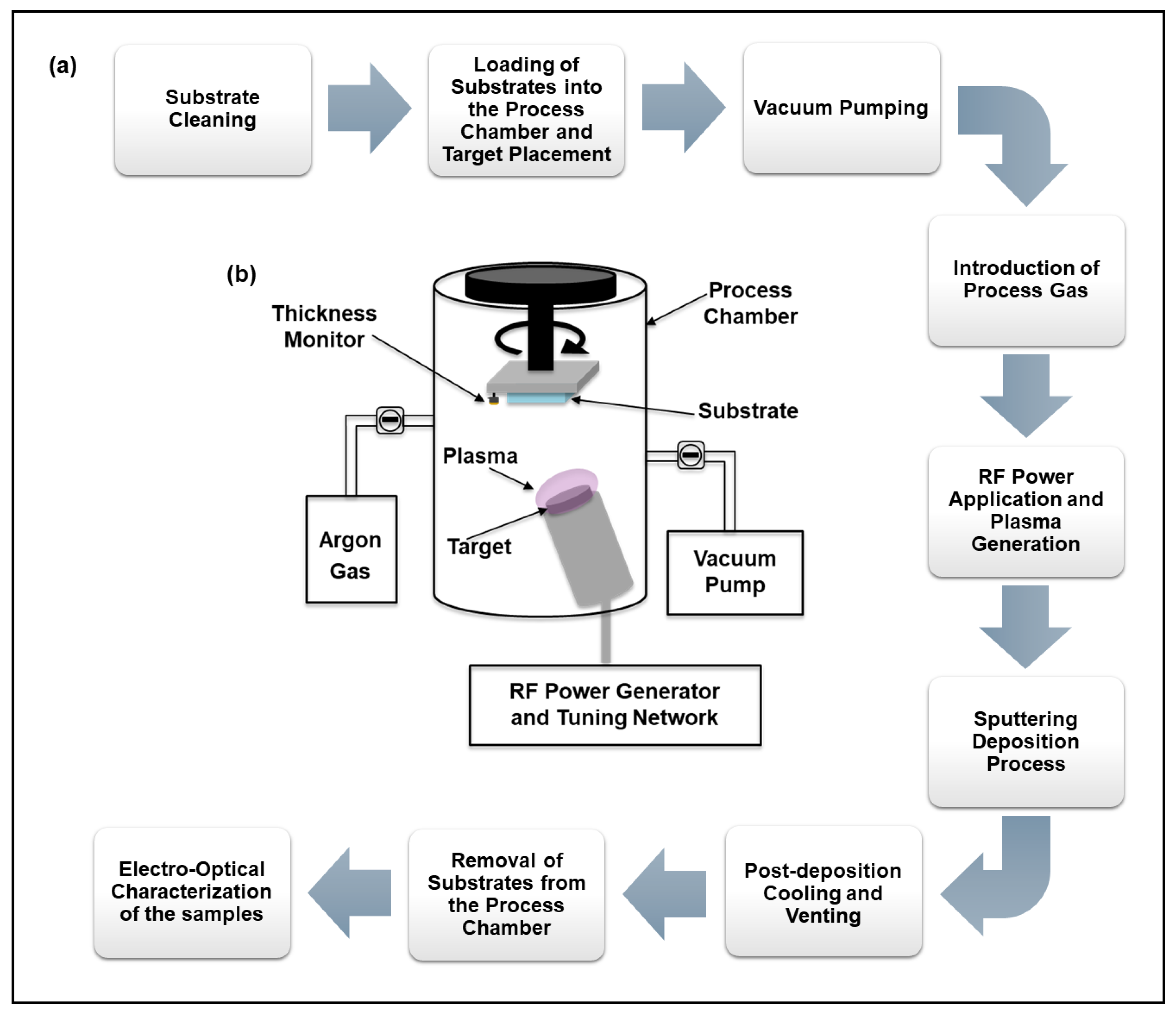
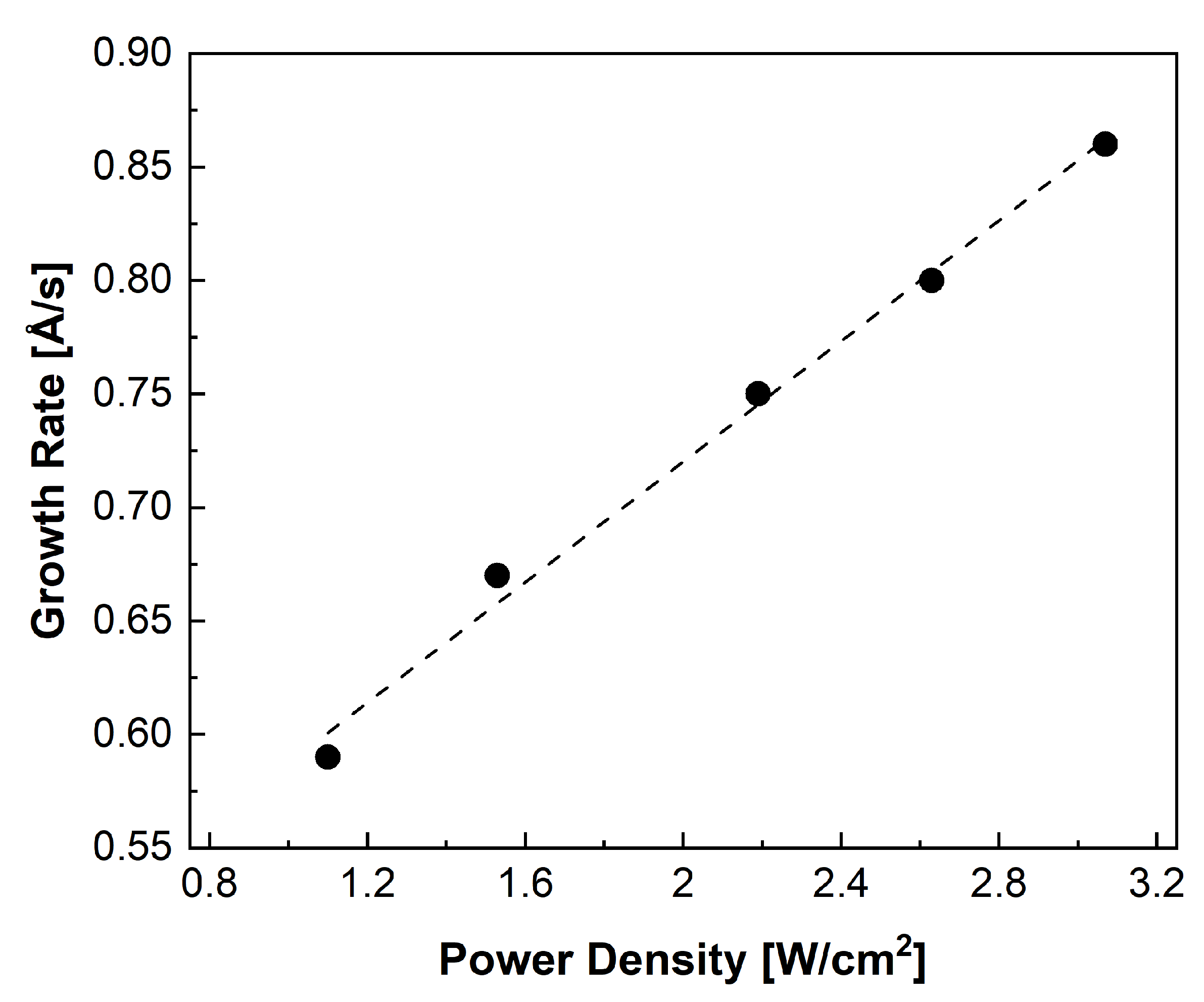

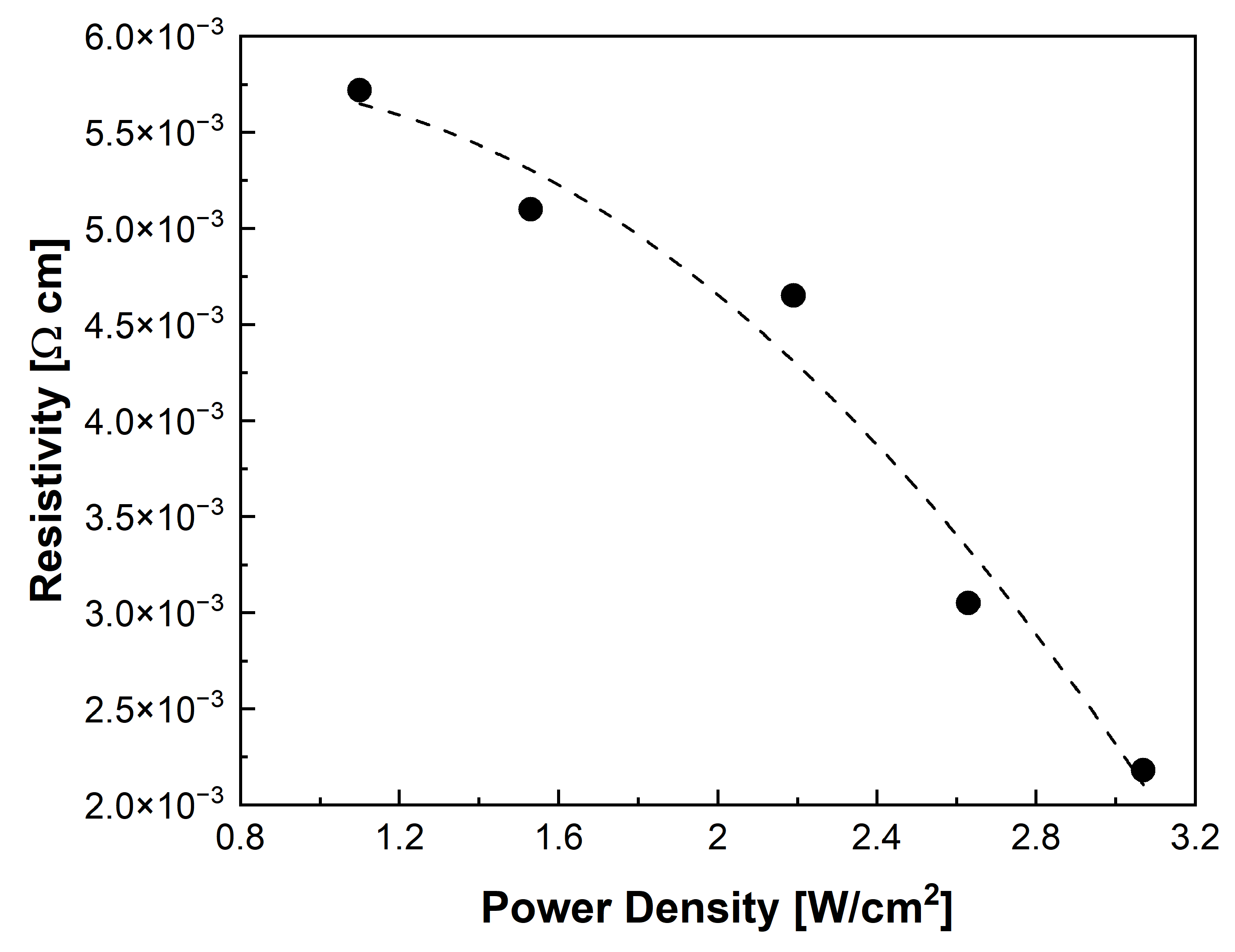

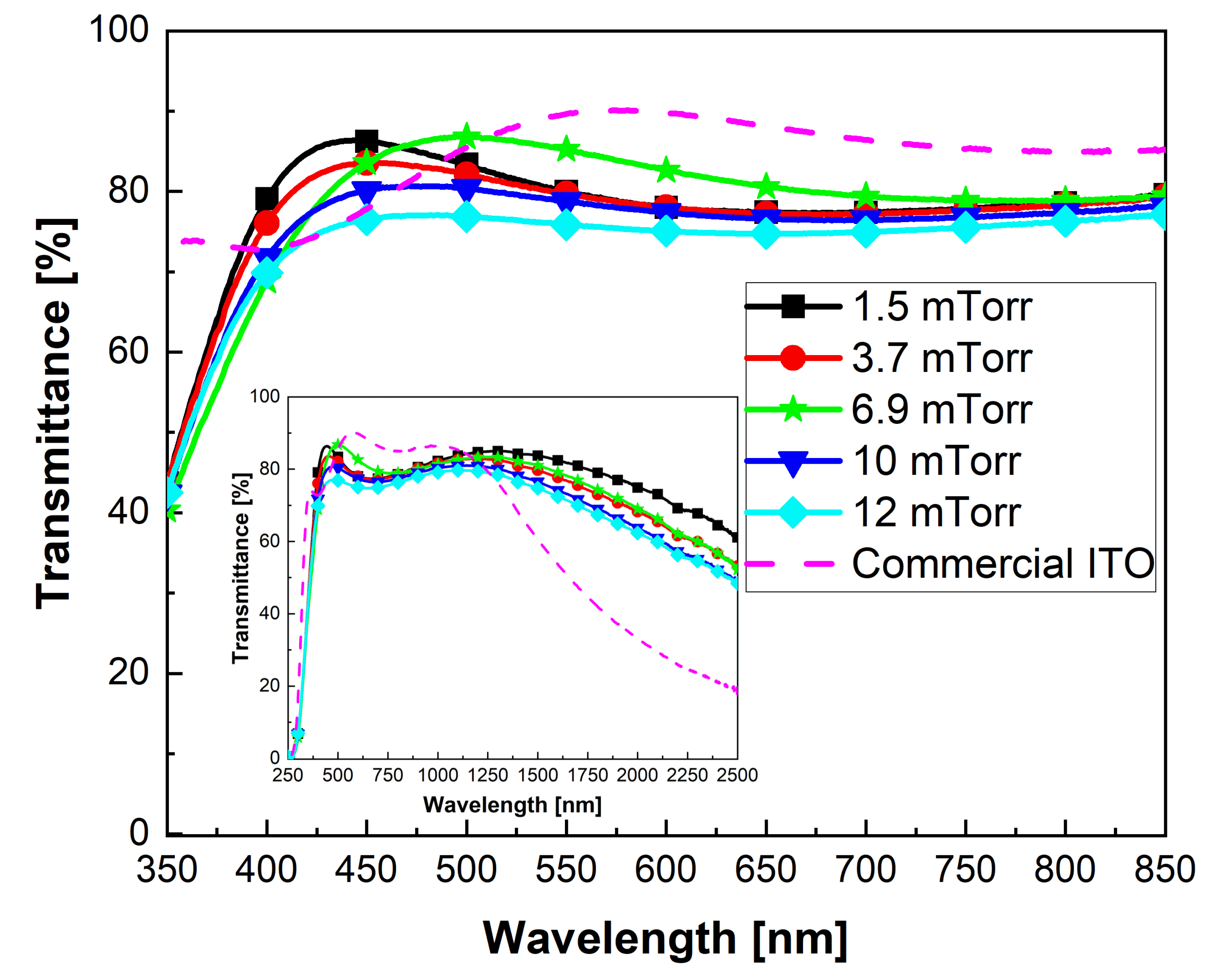
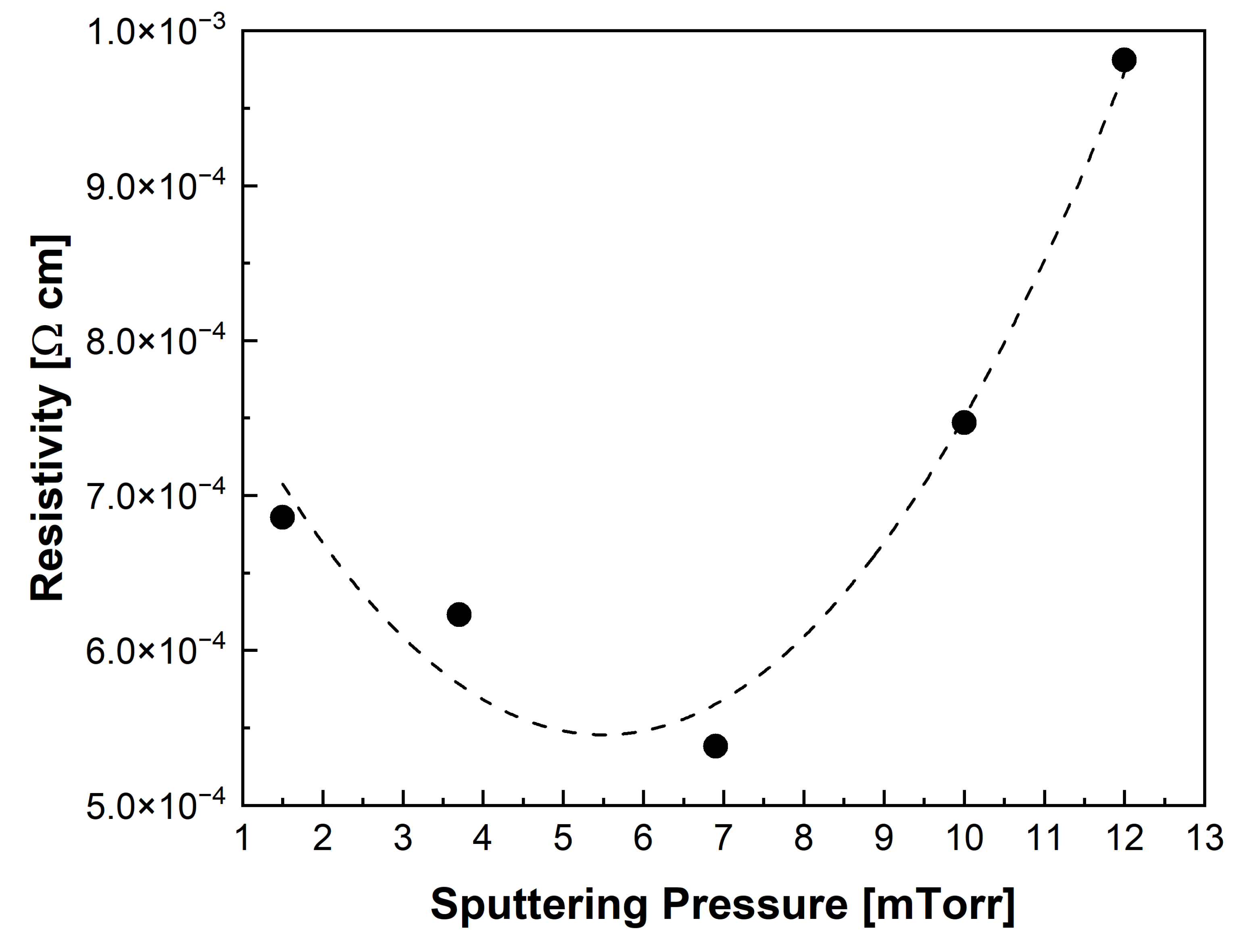
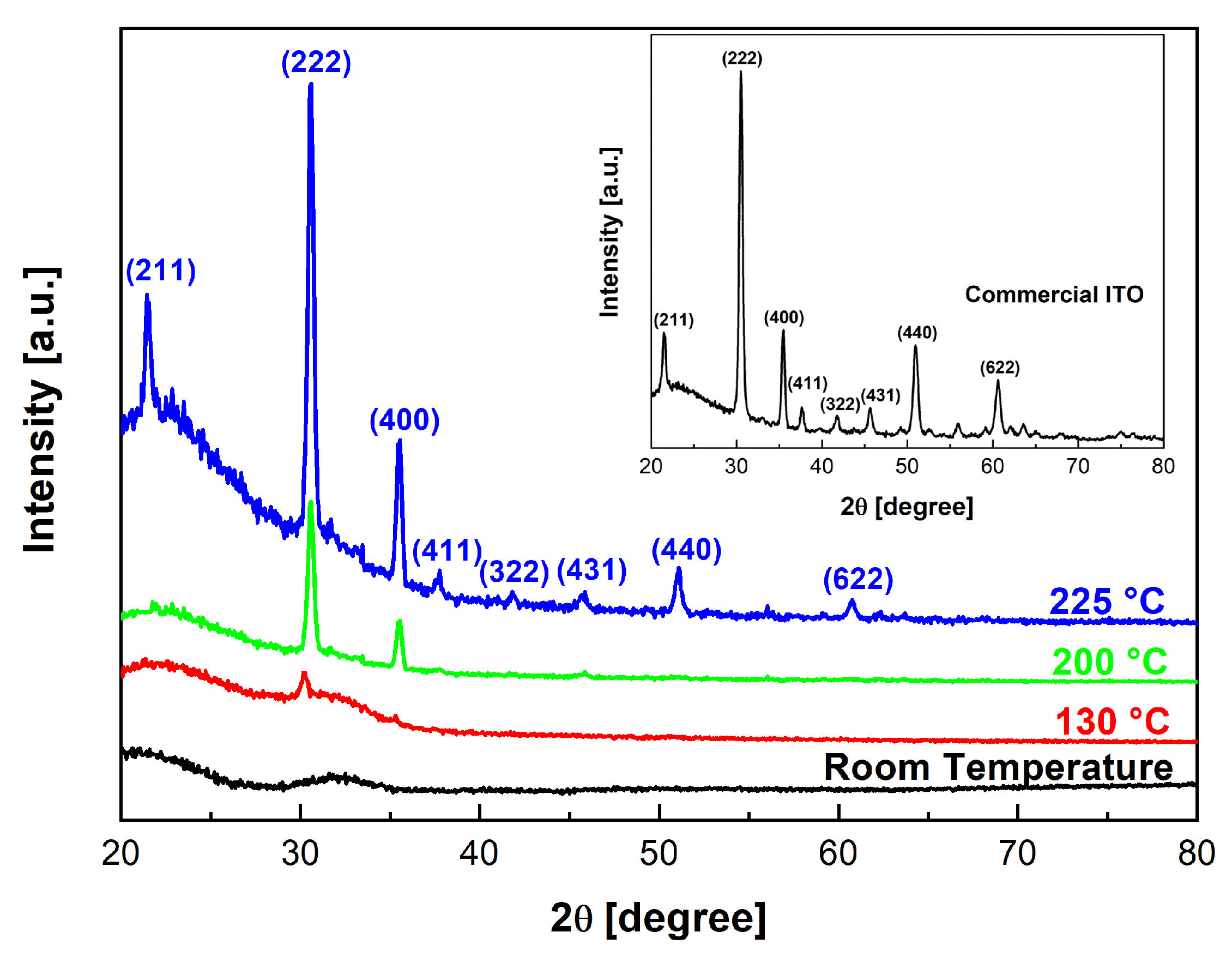
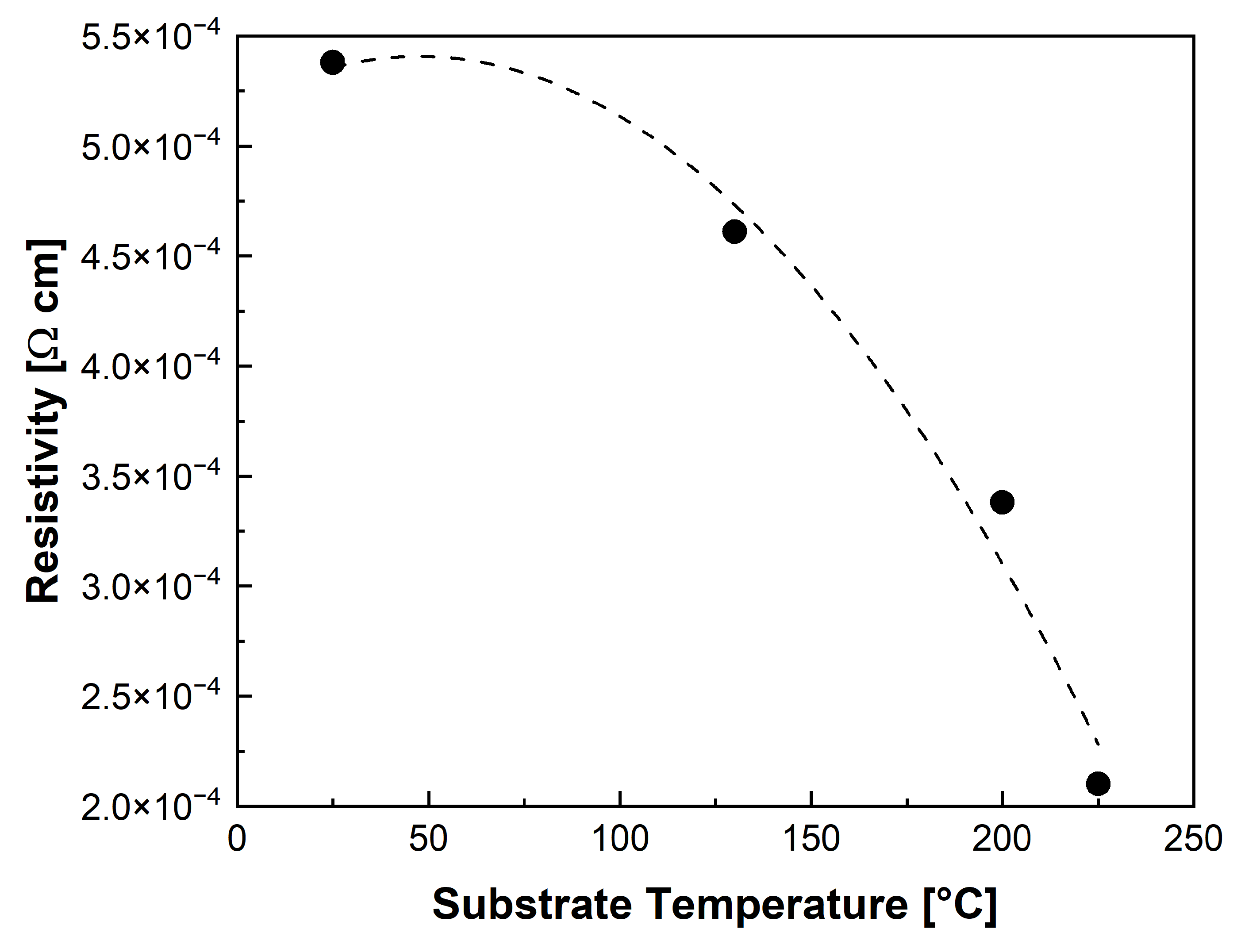
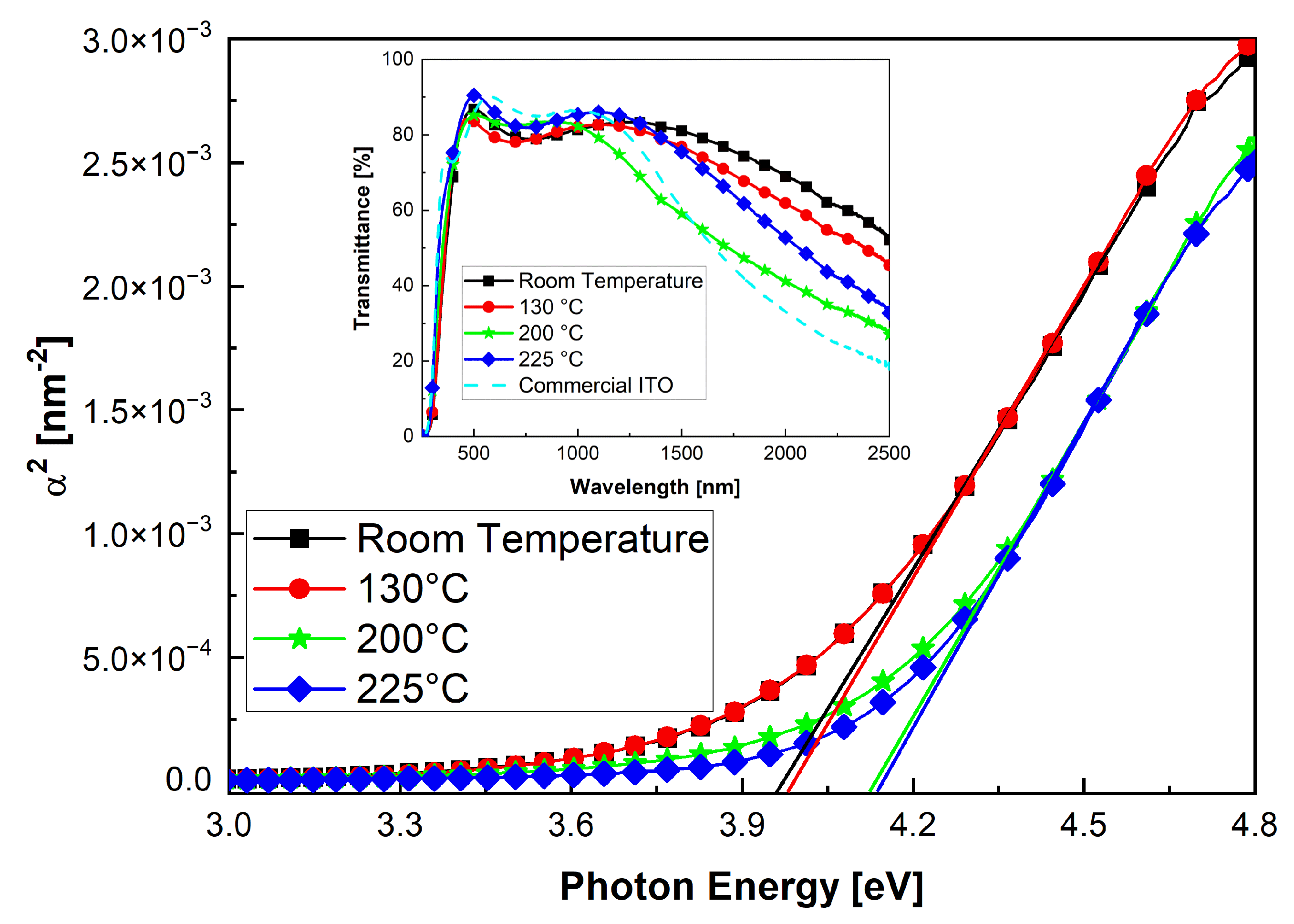
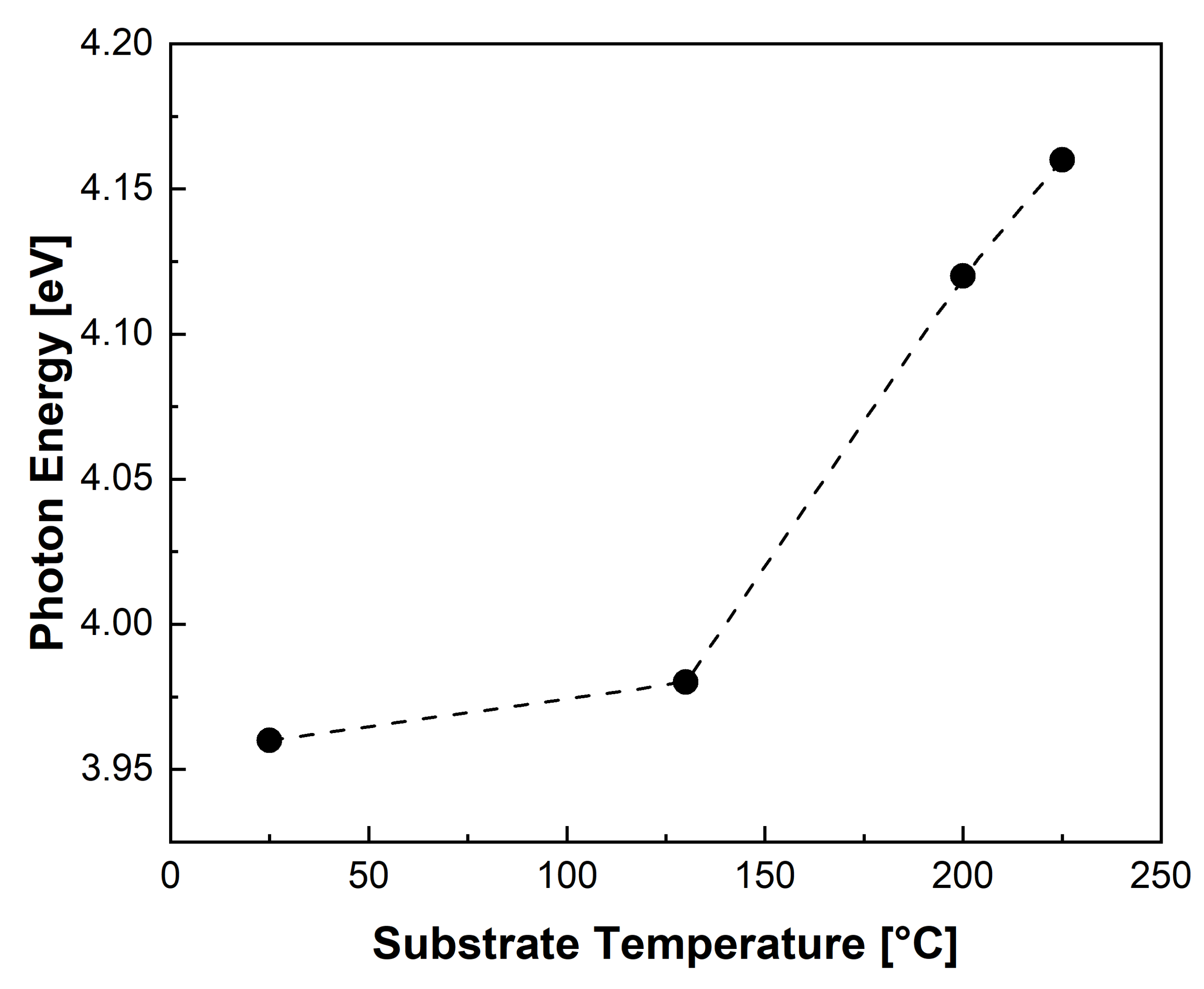
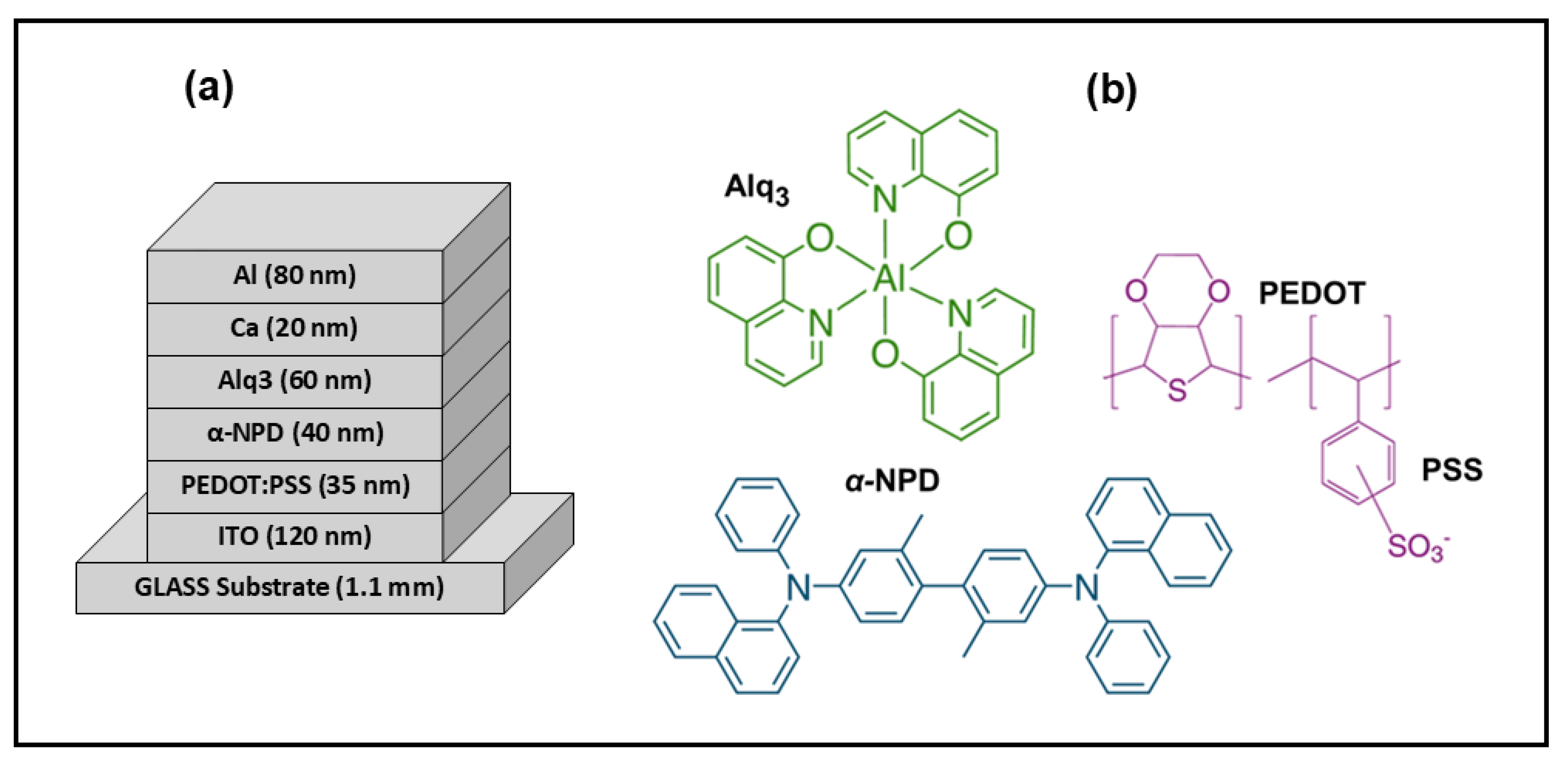
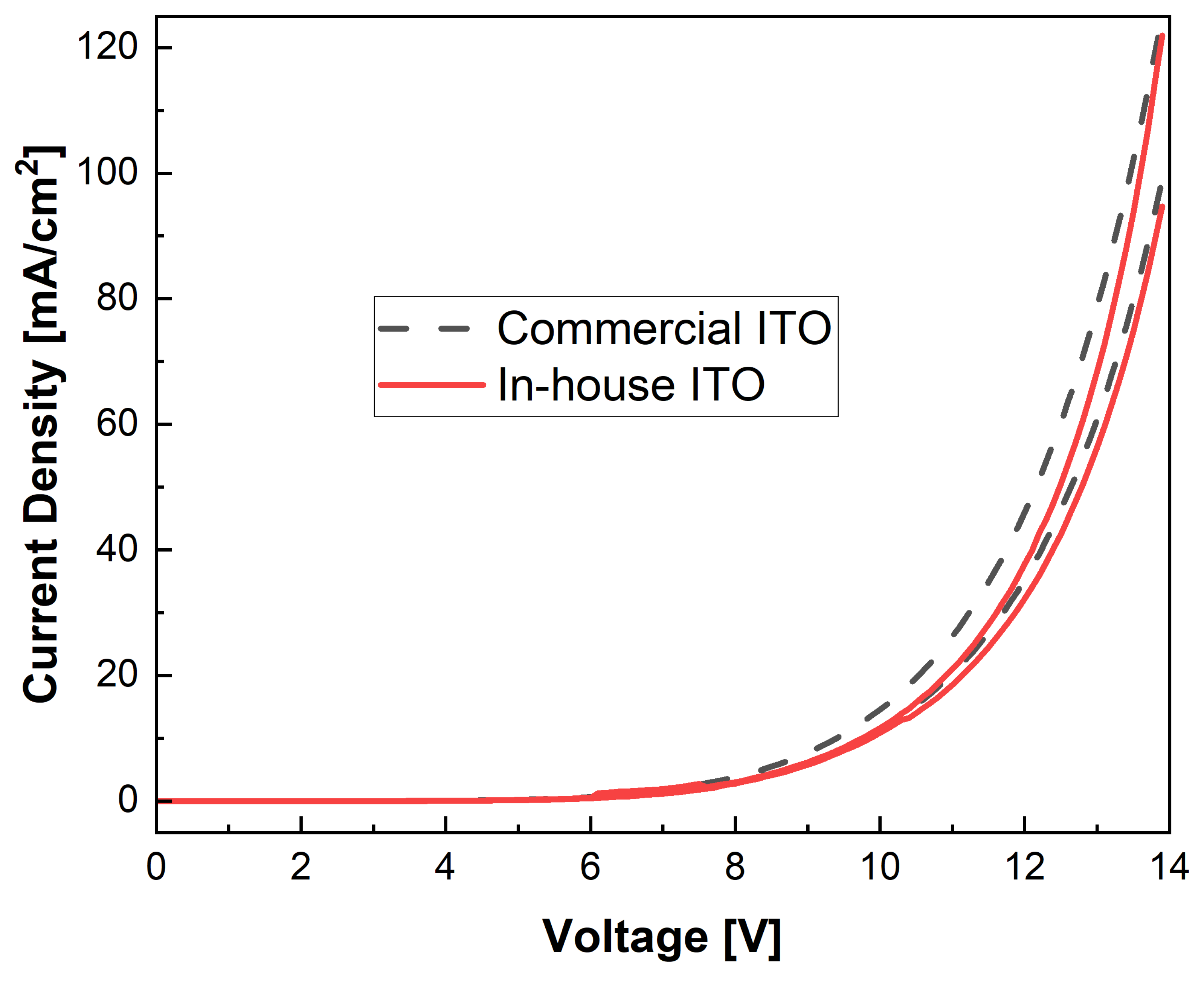
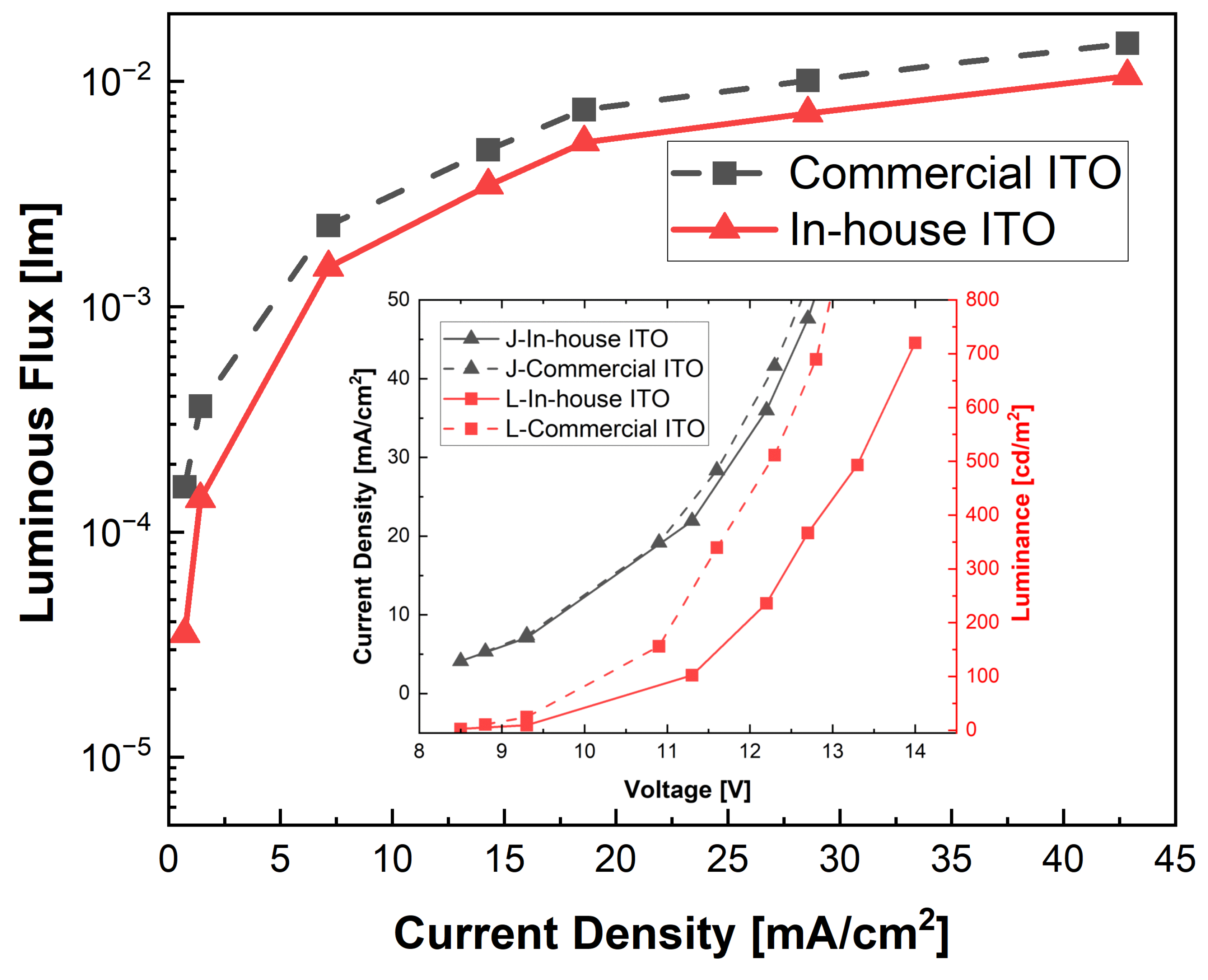
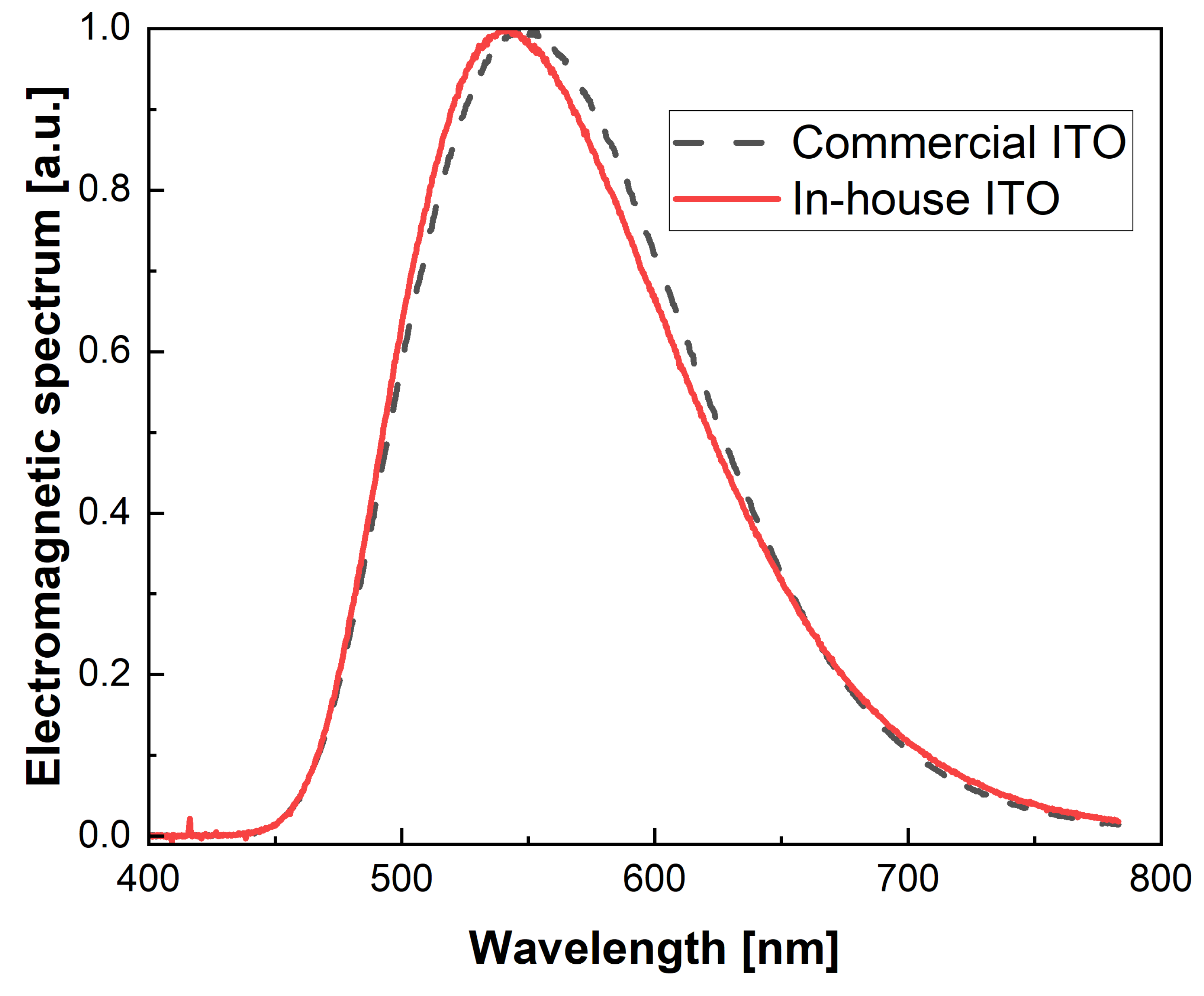
| Sample | Pressure | Power Density | Growth Rate | Resistivity | Thickness |
|---|---|---|---|---|---|
| [mTorr] | [W/cm2] | [Å/s] | [Ω cm] × 10−3 | [nm] | |
| Sample 1 | 15 | 1.10 | 0.59 | 60 | |
| Sample 2 | 15 | 1.53 | 0.67 | 91 | |
| Sample 3 | 15 | 2.19 | 0.75 | 107 | |
| Sample 4 | 15 | 2.63 | 0.80 | 100 | |
| Sample 5 | 15 | 3.07 | 0.86 | 98 |
| Sample | Pressure | Power Density | Growth Rate | Resistivity | Thickness |
|---|---|---|---|---|---|
| [mTorr] | [W/cm2] | [Å/s] | [Ω cm] × 10−4 | [nm] | |
| Sample 6 | 1.5 | 2.19 | 0.82 | 99 | |
| Sample 7 | 3.7 | 2.19 | 0.94 | 96 | |
| Sample 8 | 6.9 | 2.19 | 0.96 | 106 | |
| Sample 9 | 10 | 2.19 | 0.87 | 97 | |
| Sample 10 | 12 | 2.19 | 0.79 | 98 |
Disclaimer/Publisher’s Note: The statements, opinions and data contained in all publications are solely those of the individual author(s) and contributor(s) and not of MDPI and/or the editor(s). MDPI and/or the editor(s) disclaim responsibility for any injury to people or property resulting from any ideas, methods, instructions or products referred to in the content. |
© 2024 by the authors. Licensee MDPI, Basel, Switzerland. This article is an open access article distributed under the terms and conditions of the Creative Commons Attribution (CC BY) license (https://creativecommons.org/licenses/by/4.0/).
Share and Cite
Diletto, C.; Nunziata, F.; Aprano, S.; Migliaccio, L.; Maglione, M.G.; Rubino, A.; Tassini, P. Influence of Process Parameters on Properties of Non-Reactive RF Magnetron-Sputtered Indium Tin Oxide Thin Films Used as Electrodes for Organic Light-Emitting Diodes. Crystals 2024, 14, 776. https://doi.org/10.3390/cryst14090776
Diletto C, Nunziata F, Aprano S, Migliaccio L, Maglione MG, Rubino A, Tassini P. Influence of Process Parameters on Properties of Non-Reactive RF Magnetron-Sputtered Indium Tin Oxide Thin Films Used as Electrodes for Organic Light-Emitting Diodes. Crystals. 2024; 14(9):776. https://doi.org/10.3390/cryst14090776
Chicago/Turabian StyleDiletto, Claudia, Fiorita Nunziata, Salvatore Aprano, Ludovico Migliaccio, Maria Grazia Maglione, Alfredo Rubino, and Paolo Tassini. 2024. "Influence of Process Parameters on Properties of Non-Reactive RF Magnetron-Sputtered Indium Tin Oxide Thin Films Used as Electrodes for Organic Light-Emitting Diodes" Crystals 14, no. 9: 776. https://doi.org/10.3390/cryst14090776
APA StyleDiletto, C., Nunziata, F., Aprano, S., Migliaccio, L., Maglione, M. G., Rubino, A., & Tassini, P. (2024). Influence of Process Parameters on Properties of Non-Reactive RF Magnetron-Sputtered Indium Tin Oxide Thin Films Used as Electrodes for Organic Light-Emitting Diodes. Crystals, 14(9), 776. https://doi.org/10.3390/cryst14090776






